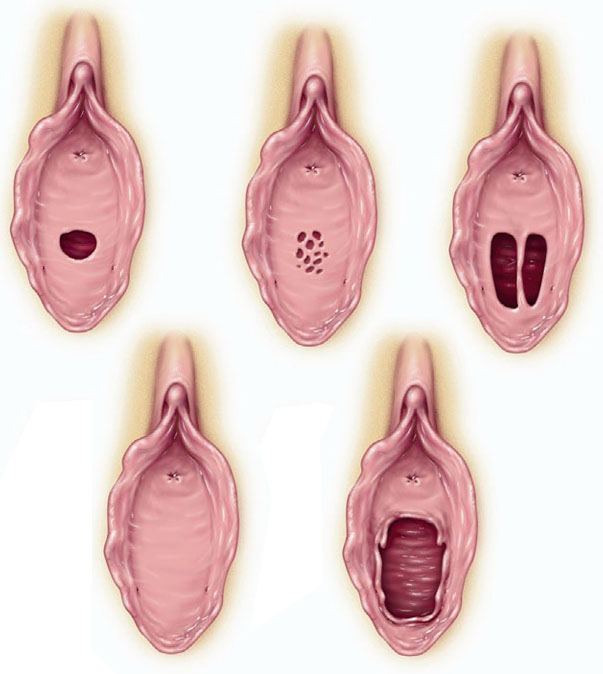“Hymen” derives from the Greek for membrane. Hymen was also the Greek god of marriage. These two facts summarize the conventional wisdom about this widely misunderstood tissue, that this fabled membrane covers the vaginal opening, and is “pierced,” “broken,” or “torn asunder” when women wed and have intercourse, presumably for the first time.
For thousands of years, many cultures have believed that “breaking” the hymen caused pain, hence the belief, still current, that women experience–in fact, should experience–pain on first intercourse. In addition, some cultures have believed that if questions arose about a young woman’s virginity, an examination could determine whether she was or wasn’t. An intact hymen demonstrated her virtue while anything else proved she’d already been deflowered. Many cultures have also believed that “piercing” the hymen caused bleeding. In these cultures, shortly after weddings, new husbands were expected to produce bloody sheets to prove they’d (1) married virgins, and (2) consummated the marriage.
Ridiculous. Here’s the rare truth about the widely misunderstood hymen.
For reasons that remain unclear, female babies are born with membranes surrounding their vaginal openings. Most hymens are doughnut shaped and open in the center. Newborns’ hymens tend to be prominent and thick. But as the years pass, most hymenal tissue thins and the opening widens. During childhood most hymenal tissue wears away as a result of washing, walking, athletics, self-exploration, and masturbation, though little bits may remain around the vaginal opening, particularly in the area closest to the anus (hymenal tags).
The intact hymen almost never covers the entire vagina. If it did, virgin girls could not menstruate. However, the opening may not look like a doughnut hole. In some women, it has a ladder-like appearance with bands of tissue extending from one side to the other. In others, it resembles a honeycomb with multiple small openings. And in rare cases, an estimated one in 200, the hymen’s single opening is so small that fingers, tampons, and erections may not be able to enter comfortably or at all (imperforate hymen). For women with imperforate hymens, a simple surgical procedure snips away the excess tissue. But in most women, by adolescence, any remaining hymenal tissue offers no significant impediment to using tampons or enjoying pain-free intercourse.
If hymenal tissue has largely worn away by adolescence, why do so many women experience pain on first intercourse? The sexological literature is oddly quiet on this issue. But I have a few ideas:
Pain on intercourse is a fairly common gynecological problem. It may be caused by many conditions. Some pain on first intercourse may have to do with medical issues.
Because of the mythology surrounding the hymen, many (most?) women expect first intercourse to hurt, which may become a self-fulfilling prophecy. The expectation of pain causes anxiety, which can turn minor discomfort into pain.
According to the National Health and Social Life Survey (1994), about one-third of women recall not wanting sex their first time or recall being forced into it during incest, sexual assault, or other coercion or exploitation. Exploitive or assaultive sex can cause tremendous anxiety and produce or aggravate pain.
Even when women fully consent to first intercourse, an estimated “75 percent feel unprepared and find their initial sexual experience distasteful,” according to the late sex therapist Sandra Leiblum, Ph.D. “Young Romeos, even those who care deeply about their girlfriends, typically lack the sexual skill and finesse for enjoyable intercourse.” Fearful that women may change their minds, young men often rush into intercourse before women feel emotionally ready for it, and before their vaginas have become sufficiently relaxed and receptive for pain-free intercourse. Once erections enter young women, the men they’re attached to often imitate the pounding, piston-like action of pornography. Such mechanical, non-sensual sex can also cause pain.
Even if first intercourse is totally consensual and loving, sweet, and sensual, natural anxiety around their first time may interfere with women’s release of vaginal lubrication. Poorly lubricated intercourse also contributes to painful intercourse.
Residual hymenal tissue may also contribute to discomfort or pain, but for the vast majority of women, hymen issues play a minor, if any role in pain on first intercourse (unless the woman has an imperforate hymen that has not been reduced beforehand).
Finally, what about all those bloody sheets? Rushed, nonsensual, poorly lubricated, piston-like intercourse might abrade sensitive vaginal tissue enough to cause bleeding. But throughout history, in cultures that have insisted on female virginity at marriage, the stakes have been very high. No blood on the sheets deeply dishonored the bride’s family and might even bring charges of marital fraud. Many brides have taken no chances. Often under their mothers’ direction, they have filed a fingernail to a sharp point and on their wedding night, cut themselves on the thigh, producing enough blood to stain the sheets and satisfy tradition–and the mythology surrounding the hymen.

Source
[ads1]
Leave a Reply